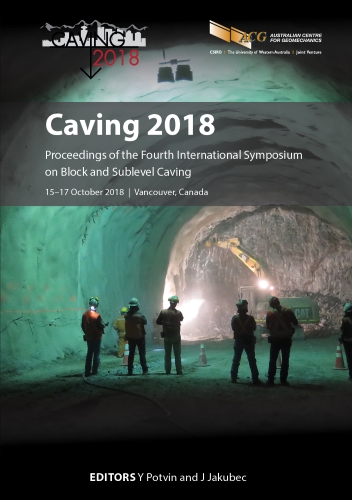Microseismic monitoring of the Oyu Tolgoi Hugo North Lift 1

|
Authors: Mercier, J-P; van As, A; Carlson, C; Tumur-Ochir, B |
DOI https://doi.org/10.36487/ACG_rep/1815_65_Mercier
Cite As:
Mercier, J-P, van As, A, Carlson, C & Tumur-Ochir, B 2018, 'Microseismic monitoring of the Oyu Tolgoi Hugo North Lift 1', in Y Potvin & J Jakubec (eds), Caving 2018: Proceedings of the Fourth International Symposium on Block and Sublevel Caving, Australian Centre for Geomechanics, Perth, pp. 823-834, https://doi.org/10.36487/ACG_rep/1815_65_Mercier
Abstract:
Oyu Tolgoi is a copper–gold mine in the South Gobi region of Mongolia located approximately 550 km south of the capital Ulaanbaatar, near the Chinese border. The Oyu Tolgoi mine is expanding underground to exploit the Hugo North deposit, one of several large-scale orebodies of the Oyu Tolgoi complex. The Hugo North deposit extends over 900 m vertically, from 500 to -400 MASL (670 m below the surface to 1,570 m below the surface), and is approximately 1,800 m long and 500 m wide. Mining of the Hugo North deposit will be done in stages using block caving. In the first stage, referred to as Lift 1, the top 400 m of the orebody will be mined. A microseismic monitoring system comprising 128 triaxial sensors is currently being commissioned to cover the Hugo North Lift 1 cave and the critical infrastructure underground. The purpose of the microseismic system is to provide information on the cave growth, and monitor and evaluate the seismic risk around the mine. The cave area is, to a large extent, covered by an array of 90 triaxial sensors installed and grouted in 15 deep boreholes that surround the orebody. The boreholes are drilled from surface and vary in length between approximately 80 and 1,250 m. Additional sensors are deployed underground in a series of short boreholes. The commissioning and the operation of the Hugo North Lift 1 microseismic monitoring system pose significant challenges. Installing seismic sensors in 127 mm diameter (PQ) boreholes of more than 1,000 m is not trivial, and had, as far as we know, never been achieved before in a mining context.
Keywords: microseismic, monitoring, geotechnical, block caving, drilling, sensor installation
References:
Baig, A & Urbancic, T 2010, ‘Microseismic moment tensors: a path to understanding frac growth’, The Leading Edge, vol. 29, no. 3, pp. 320–324.
Boxwell, M 2010, Solar Electricity Handbook: A Simple, Practical Guide to Solar Energy-Designing and Installing Photovoltaic Solar Electric Systems, Greenstream Publishing, Coventry.
Glazer, S 2016, ‘Palabora Lift 2 mine seismic system’, Mine Seismology: Data Analysis and Interpretation, Springer, Basel,
pp. 365–378.
Hons, MS 2008, Seismic Sensing: Comparison of Geophones and Accelerometers Using Laboratory and Field Data, MaSc thesis, University of Calgary, Calgary, , pp. 6–7.
Hudyma, M & Potvin, Y 2008, ‘Characterizing caving induced seismicity at Ridgeway gold mine’, in H Schunnesson & E Nordlund (eds), Proceedings of MassMin 2008, Luleå University of Technology, Luleå, pp. 931–942.
Hudyma, M, Potvin, Y & Allison, D 2007, ‘Seismic monitoring of the Northparkes Lift 2 block cave - part 1 undercutting’, Journal of the Southern African Institute of Mining and Metallurgy, pp. 303–334.
Laubscher, DH 1994, ‘Cave mining - the state of the art’, Journal of The Southern African Institute of Mining and Metallurgy, vol. 94, no. 10, pp. 279–293.
Mercier, J-P, de Beer, W, Mercier, J-P & Morris, S 2015, ‘Evolution of a block cave from time-lapse passive source body-wave traveltime tomography’, Geophysics, vol. 80, no. 2, WA85–WA97,
Olivier, G, Brenguier, F, Campillo, M, Lynch, R & Roux, P 2015, ‘Body-wave reconstruction from ambient seismic noise correlations in an underground mine’, Geophysics, vol. 80, no. 3, KS11–25,
Olivier, G, Brenguier, F, Campillo, M, Roux, P, Shapiro, N & Lynch, R 2015, ‘Investigation of coseismic and postseismic processes using in situ measurements of seismic velocity variations in an underground mine’, Geophysical Research Letters, vol. 42, no. 21, pp. 9261–9269.
Pierce, ME 2010, A Model for Gravity Flow of Fragmented Rock in Block Caving Mines, PhD thesis, The University of Queensland, Brisbane.
Rahal, D, Smith, M, Van Hout, G & Von Johannides, A 2003, ‘The use of mixed integer linear programming for long-term scheduling in block caving mines’, in FA Camisani-Calzolari (ed.), Proceedings of the 31st International Symposium on Application of Computers and Operations Research in the Minerals Industries, The South African Institute of Mining and Metallurgy, Johannesburg, pp. 123–131.
Rawlinson, N, Hauser, J & Sambridge, M 2008, ‘Seismic ray tracing and wavefront tracking in laterally heterogeneous media’, Advances in Geophysics, vol. 49, pp. 203–273.
Sethian, JA 1999, ‘Fast marching methods’, SIAM Review, vol. 41, no. 2, pp. 199–235.
Vyazmensky, A, Elmo, D & Stead, D 2010, ‘Role of rock mass fabric and faulting in the development of block caving induced surface subsidence’, Rock Mechanics and Rock Engineering, vol. 43, no. 5, pp. 533–556,
Westman, E 2012, ‘Passive seismic tomography for three-dimensional time-lapse imaging of mining-induced rock mass changes’, The Leading Edge, vol. 31, no. 3, pp. 338–342.
White, H, de Beer, W, White, H & van As, A 2004, ‘Design and implementation of seismic monitoring systems in a block-cave environment’, in K Karzulowicz & MA Alfaro (eds), Proceedings of MassMin 2004, Instituto de Ingenieros de Chile, Santiago.
© Copyright 2025, Australian Centre for Geomechanics (ACG), The University of Western Australia. All rights reserved.
View copyright/legal information
Please direct any queries or error reports to repository-acg@uwa.edu.au
View copyright/legal information
Please direct any queries or error reports to repository-acg@uwa.edu.au
